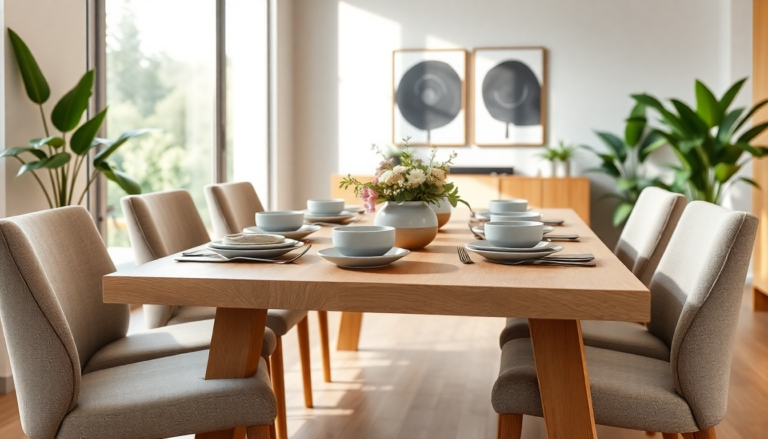Argomenti trattati
Have you noticed how the dining room has transformed over the years? What was once a formal space reserved for special occasions is now a vibrant area that reflects our everyday lives. This shift is largely driven by changing lifestyles and consumer preferences, making dining furniture not just functional but also aesthetically pleasing. Today, it’s all about creating an inviting atmosphere that enhances the overall dining experience while being mindful of sustainability and innovation.
Emerging Trends in Dining Furniture
One of the most exciting trends in dining furniture is the rise of adaptable dining tables. Imagine hosting a dinner party and easily extending your table to accommodate everyone without sacrificing style. This flexibility meets the demands of modern households, where gathering friends and family is more than just an event—it’s a cherished ritual.
But the conversation doesn’t stop there; sustainability is also a key player in today’s market. More and more consumers are becoming environmentally conscious, seeking furniture made from reclaimed wood, bamboo, and other eco-friendly materials. This trend not only supports sustainability but also adds a unique character to each piece—after all, no two items crafted from natural materials are exactly alike.
Another trend we’re seeing is a delightful blend of styles. Mid-century modern pieces are being paired with contemporary designs, resulting in eclectic dining spaces that tell a story. This fusion allows homeowners to express their individuality, making their dining areas not just functional but personal and timeless.
Data Analysis of Consumer Preferences
So, what do the numbers tell us about consumer preferences in the dining furniture market? Well, recent studies reveal some fascinating insights. For instance, nearly 70% of consumers prioritize comfort when selecting dining furniture, closely followed by style. Isn’t it interesting that today’s buyers are willing to invest up to 20% more for sustainable options? This shift highlights a growing purchasing power towards brands that not only offer products but also embody a vision of environmental responsibility.
Performance metrics, such as customer satisfaction ratings and return rates, are valuable tools for manufacturers. High satisfaction scores often correlate with products that focus on comfort and adaptability, while lower rates might point to issues with durability or aesthetic appeal. By harnessing these data points, brands can fine-tune their offerings to align more closely with consumer expectations.
Case Study: Successful Dining Furniture Brands
Let’s dive into a case study that perfectly illustrates the impact of these trends. Consider a leading dining furniture brand that took a data-driven approach to optimize their product line. Renowned for its commitment to sustainability, this brand introduced a range of dining tables crafted from reclaimed wood, resonating deeply with eco-conscious consumers.
Upon launching, they closely monitored key performance indicators (KPIs) such as sales figures, customer reviews, and social media engagement. The data revealed a significant uptick in sales during the first quarter, with a Return on Ad Spend (ROAS) that exceeded expectations. This success stemmed from effective marketing strategies that highlighted the unique story behind each piece, tapping into consumers’ desire for authenticity.
What’s more, the brand didn’t stop there. They leveraged customer feedback for continuous improvement. By analyzing reviews and conducting surveys, they gained valuable insights into customer preferences regarding design, size, and features, leading to an iterative process of product development.
Practical Tactics for Implementing Trends
If you’re looking to refresh your dining space, there are several practical tactics to consider. Start by assessing the size and layout of your dining area to determine the most suitable table shape and size. An extendable table could be your best friend, especially if you often entertain guests.
Next, think about integrating multifunctional pieces, like benches or storage options, that complement your dining setup while maximizing space. This approach not only enhances functionality but also creates a cozy atmosphere—who wouldn’t want that?
And don’t shy away from mixing and matching styles! Pair a sleek, modern table with vintage chairs, or introduce bold colors to craft a dynamic and inviting dining experience. The key is to curate a space that reflects your personal style while remaining practical.
Key Performance Indicators to Monitor
As you embark on your dining furniture journey, keeping an eye on specific KPIs will be essential in guiding your choices. Start by monitoring customer satisfaction through reviews and feedback, focusing on aspects like comfort, design, and durability. Additionally, keep track of sales trends to determine which styles and materials resonate most with your demographic.
Don’t forget to track inventory turnover rates, as this can provide valuable insights into popular items, enabling you to make informed purchasing decisions. By staying attuned to these metrics, you can optimize your dining area not just to meet your needs but also to delight your guests.

